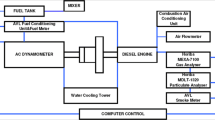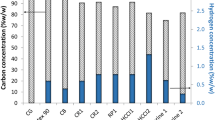Abstract
A chemical characterization of diesel and hydrotreated vegetable oil (HVO) soot has been developed using diffuse reflectance infrared Fourier transform spectroscopy (DRIFTS) before and after the reaction with different probe gases. Samples were generated under combustion conditions corresponding to an urban operation mode of a diesel engine and were reacted with probe gas-phase molecules in a Knudsen flow reactor. Specifically, NH2OH, O3 and NO2 were used as reactants (probes) and selected according to their reactivities towards specific functional groups on the sample surface. Samples of previously ground soot were diluted with KBr and were introduced in a DRIFTS accessory. A comparison between unreacted and reacted soot samples was made in order to establish chemical changes on the soot surface upon reaction. It was concluded that the interface of diesel and HVO soot before reaction mainly consists polycyclic aromatic hydrocarbons, nitro and carbonyl compounds, as well as ether functionalities. The main difference between both soot samples was observed in the band of the C=O groups that in diesel soot was observed at 1719 cm−1 but not in HVO soot. After reaction with probe gases, it was found that nitro compounds remain on the soot surface, that the degree of unsaturation decreases for reacted samples, and that new spectral bands such as hydroxyl groups are observed.








Similar content being viewed by others
References
Agudelo JR, Álvarez A, Armas O (2014) Impact of crude vegetable oils on the oxidation reactivity and nanostructure of diesel particulate matter. Combust Flame 161:2904–2915. doi:10.1016/j.combustflame.2014.05.013
Cain JP, Gassman PL, Wang H, Laskin A (2010) Micro-FTIR study of soot chemical composition—evidence of aliphatic hydrocarbons on nascent soot surfaces. Phys Chem Chem Phys 12:5206–5218
Carrara M, Wolf JC, Niessner R (2010) Nitro-PAH formation studied by interacting artificially PAH-coated soot aerosol with NO2 in the temperature range of 295-523 K. Atmos Environ 44:3878–3885. doi:10.1016/j.atmosenv.2010.07.032
Daly HM, Horn AB (2009) Heterogenous chemistry of toluene, kerosene and diesel soots. Phys Chem Chem Phys 11:1069–1076. doi:10.1039/B815400G
Gaddam CK, Vander Wal RL (2013) Physical and chemical characterization of SIDI engine particulates. Combust Flame 160:2517–2528. doi:10.1016/j.combustflame.2013.05.025
Heeb NV, Schmid P, Kohler M, Gujer E, Zennegg M, Wenger D, Wichser A, Ulrich A, Gfeller U, Honegger P, Zeyer K, Emmenegger L, Petermann JL, Czerwinski J, Mosimann T, Kasper M, Mayer A (2008) Secondary effects of catalytic diesel particulate filters: conversion of PAHs versus formation of nitro-PAHs. Environ Sci Technol 42:3773–3779. doi:10.1021/es7026949
Jäger C, Huisken F, Mutschke H, Henning T, Poppitz W, Voicu I (2007) Identification and spectral properties of PAHs in carbonaceous material produced by laser pyrolysis. Carbon 45:2981–2994. doi:10.1016/j.carbon.2007.09.046
Kelly FJ, Fussell JC (2012) Size, source and chemical composition as determinants of toxicity attributable to ambient particulate matter. Atmos Environ 60:504–526. doi:10.1016/j.atmosenv.2012.06.039
Kuronen M, Mikkonen S, Aakko P, Murtonen T (2007) Hydrotreated vegetable oil as fuel for heavy duty diesel engines. Technical Paper. SAE 2007 Commercial Vehicle Engineering Congress & Exhibition. doi:10.4271/2007-01-4031
Lapuerta M, Armas O, Rodríguez-Fernández J (2008) Effect of biodiesel fuels on diesel engine emissions. Prog Energy Combust Sci 34:198–223. doi:10.1016/j.pecs.2007.07.001
Lapuerta M, Oliva F, Agudelo JR, Boehman AL (2012) Effect of fuel on the soot nanostructure and consequences on loading and regeneration of diesel particulate filters. Combust Flame 159:844–853. doi:10.1016/j.combustflame.2011.09.003
Lapuerta M, Rodríguez-Fernández J, Sánchez-Valdepeñas J, Salgado MS (2016) Multi-technique analysis of soot reactivity from conventional and paraffinic diesel fuels. Flow Turbulence Combust 96:327–341. doi:10.1007/s10494-015-9644-y
Li P, Du G, Cai W, Shao X (2012) Rapid and nondestructive analysis of pharmaceutical products using near-infrared diffuse reflectance spectroscopy. J Phar Biomed Anal 70:288–294. doi:10.1016/j.jpba.2012.07.013
Messerer A, Niessner R, Pöschl U (2006) Comprehensive kinetic characterization of the oxidation and gasification of model and real diesel soot by nitrogen oxides and oxygen under engine exhaust conditions: measurement, Langmuir-Hinshelwood, and Arrhenius parameters. Carbon 44:307–324. doi:10.1016/j.carbon.2005.07.017
Mirante F, Alves C, Pio C, Pindado O, Perez R, Revuelta MA, Artiñano B (2013) Organic composition of size segregated atmospheric particulate matter, during summer and winter sampling campaigns at representative sites in Madrid, Spain. Atmos Res 132-133:345–361. doi:10.1016/j.atmosres.2013.07.005
Muckenhuber H, Grothe H (2006) The heterogeneous reaction between soot and NO2 at elevated temperature. Carbon 44:546–559. doi:10.1016/j.carbon.2005.08.003
Muckenhuber H, Grothe H (2007) A DRIFTS study of the heterogeneous reaction of NO2 with carbonaceous materials at elevated temperature. Carbon 45:321–329. doi:10.1016/j.carbon.2006.09.019
Nithyanandan K, Lin Y, Donahue R, Meng X, Zhang J, Lee CF (2016) Characterization of soot from diesel-CNG dual-fuel combustión in a CI engine. Fuel 184:145–152. doi:10.1016/j.fuel.2016.06.028
Notter DA (2015) Life cycle impact assessment modeling for particulate matter: a new approach based on physico-chemical particle properties. Environ Inter 82:10–20. doi:10.1016/j.envint.2015.05.002
Omidvarborna H, Kumar A, Kim DS (2016) Variation of diesel soot characteristics by different types and blends of biodiesel in a laboratory combustion chamber. Sci Total Environ 544:450–459. doi:10.1016/j.scitotenv.2015.11.076
Plummer LE, Carosino CM, Bein KJ, Zhao Y, Willits N, Smiley-Jewell S, Wesler AS, Pinkerton KE (2015) Pulmonary inflammatory effects of source-oriented particulate matter from California’s San Joaquin Valley. Atmos Environ 119:174–181. doi:10.1016/j.atmosenv.2015.08.043
Popovicheva O, Engling G, Lin KT, Persiantseva N, Timofeev M, Kireeva E, Völk P, Hubert A, Wachtmeister G (2015a) Diesel/biofuel exhaust particles from modern internal combustion engines: microstructure, composition, and Hygroscopicity. Fuel 157:232–239. doi:10.1016/j.fuel.2015.04.073
Popovicheva OB, Kireeva ED, Shonija NK, Vojtisek-Lom M, Schwarz J (2015b) FTIR analysis of surface functionalities on particulate matter produced by off-road diesel engines operating on diesel and biofuel. Environ Sci Pollut Res 22:4534–4544. doi:10.1007/s11356-014-3688-8
Ramdas R, Nowicka E, Jenkins R, Sellick D, Davies C, Golunski S (2015) Using real particulate matter to evaluate combustion catalysts for direct regeneration of diesel soot filters. Appl Catal B Environ 176-177:436–443. doi:10.1016/j.apcatb.2015.04.031
Regulation (EC) (2007) No 715/2007 of the European Parliament and of the Council of 20 June 2007 on type approval of motor vehicles with respect to emissions from light passenger and commercial vehicles (Euro 5 and Euro 6) and on access to vehicle repair and maintenance information; Official Journal of the European Union L171, 1-16
Santamaría A, Mondragon F, Molina A, Marsh ND, Eddings EG, Sarofim AF (2006) FT-IR and 1HNMR characterization of the products of an ethylene inverse diffusion flame. Combust Flame 146:52–62. doi:10.1016/j.combustflame.2006.04.008
Santamaría A, Yang N, Eddings E, Mondragon F (2010) Chemical and morphological characterization of soot and soot precursors generated in an inverse diffusion flame with aromatic and aliphatic fuels. Combust Flame 157:33–42. doi:10.1016/j.combustflame.2009.09.016
Setiabudi A, Makkee M, Moulijn JA (2004) The role of NO2 and O2 in the accelerated combustion of soot in diesel exhaust gases. Appl Catal B Environ 50:185–194. doi:10.1016/j.apcatb.2004.01.004
Setyan A, Sauvain JJ, Rossi MJ (2009) The use of heterogeneous chemistry for the characterization of functional groups at the gas/particle interface of soot and TiO2 nanoparticles. Phys Chem Chem Phys 11:6205–6217. doi:10.1039/B902509J
Setyan A, Sauvain J, Guillemin M, Riediker M, Demirdjian B, Rossi MJ (2010) Probing functional groups at the gas-aerosol Interface using heterogeneous titration reactions: a tool for predicting aerosol health effects? ChemPhysChem 11:3823–3835. doi:10.1002/cphc.201000490
Stadler D, Rossi MJ (2000) The reactivity of NO2 and HONO on flame soot at ambient temperature: the influence of combustion conditions. Phys Chem Chem Phys 2:5420–5429. doi:10.1039/B005680O
Taguchi K, Fujii S, Yamano S, Cho AK, Kanisuki S, Nakai Y, Sugawara F, Froines JR, Kumagi Y (2007) An approach to evaluate two-electron reduction of 9,10-phenanthraquinone and redox activity of the hydroquinone associated with oxidative stress. Free Radical Biol Me 43:789–799. doi:10.1016/j.freeradbiomed.2007.05.021
Tapia A, Salgado MS, Martín MP, Sánchez-Valdepeñas J, Rossi MJ, Cabañas B (2015) The use of heterogeneous chemistry for the characterization of functional groups at the gas/particle interface of soot from a diesel engine at a particular running condition. Environ Sci Pollut Res 22:4863–4872. doi:10.1007/s11356-014-2976-7
Tapia A, Salgado MS, Martín MP, Lapuerta M, Rodríguez J, Rossi MJ, Cabañas B (2016a) Molecular characterization at the gas-particle interface of soot sampled from a diesel engine using a titration method. Environ Sci Technol 50:2946–2955. doi:10.1021/acs.est.5b05531
Tapia A, Salgado S, Sánchez-Valdepeñas J, Martín P, Rodríguez J, Cabañas B (2016b) Diffuse reflectance infrared Fourier transform spectroscopy (DRIFTS) applied to the chemical characterization of diesel soot. Global NEST J 18:453–462
Tabor K, Gutzwiller L, Rossi MJ (1994) Heterogeneous chemical kinetics of NO2 on amorphous carbon at ambient temperature. J Phys Chem 98:6172–6186. doi:10.1021/j100075a021
Acknowledgements
This work was supported by project CGL2014-57087-R, granted by the Ministerio de Economía y Competitividad (Spain). Neste and Repsol are acknowledged for the supply of HVO and diesel fuels, respectively.
Author information
Authors and Affiliations
Corresponding author
Additional information
Responsible editor: Philippe Garrigues
Electronic supplementary material
ESM 1
(DOCX 632 kb)
Rights and permissions
About this article
Cite this article
Tapia, A., Salgado, M.S., Martín, M.P. et al. Chemical characterization of diesel and hydrotreated vegetable oil (HVO) soot after reactive gas probing using diffuse reflectance FTIR spectroscopy (DRIFTS). Environ Sci Pollut Res 24, 7534–7543 (2017). https://doi.org/10.1007/s11356-017-8436-4
Received:
Accepted:
Published:
Issue Date:
DOI: https://doi.org/10.1007/s11356-017-8436-4




